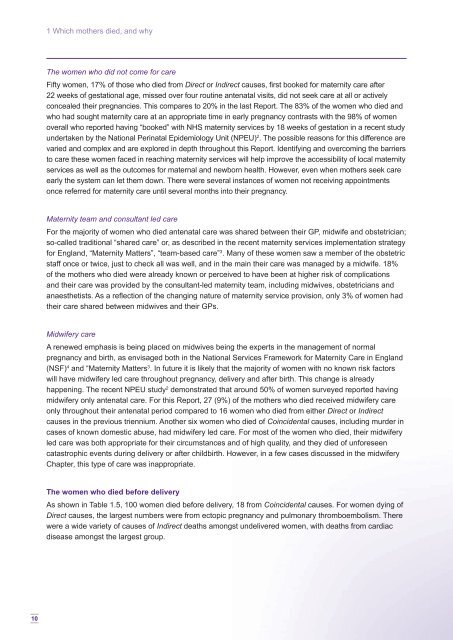Saving Mothers' Lives: - Public Health Agency for Northern Ireland
Saving Mothers' Lives: - Public Health Agency for Northern Ireland
Saving Mothers' Lives: - Public Health Agency for Northern Ireland
Create successful ePaper yourself
Turn your PDF publications into a flip-book with our unique Google optimized e-Paper software.
10<br />
1 Which mothers died, and why<br />
The women who did not come <strong>for</strong> care<br />
Fifty women, 17% of those who died from Direct or Indirect causes, fi rst booked <strong>for</strong> maternity care after<br />
22 weeks of gestational age, missed over four routine antenatal visits, did not seek care at all or actively<br />
concealed their pregnancies. This compares to 20% in the last Report. The 83% of the women who died and<br />
who had sought maternity care at an appropriate time in early pregnancy contrasts with the 98% of women<br />
overall who reported having “booked” with NHS maternity services by 18 weeks of gestation in a recent study<br />
undertaken by the National Perinatal Epidemiology Unit (NPEU) 2 . The possible reasons <strong>for</strong> this difference are<br />
varied and complex and are explored in depth throughout this Report. Identifying and overcoming the barriers<br />
to care these women faced in reaching maternity services will help improve the accessibility of local maternity<br />
services as well as the outcomes <strong>for</strong> maternal and newborn health. However, even when mothers seek care<br />
early the system can let them down. There were several instances of women not receiving appointments<br />
once referred <strong>for</strong> maternity care until several months into their pregnancy.<br />
Maternity team and consultant led care<br />
For the majority of women who died antenatal care was shared between their GP, midwife and obstetrician;<br />
so-called traditional “shared care” or, as described in the recent maternity services implementation strategy<br />
<strong>for</strong> England, “Maternity Matters”, “team-based care” 3 . Many of these women saw a member of the obstetric<br />
staff once or twice, just to check all was well, and in the main their care was managed by a midwife. 18%<br />
of the mothers who died were already known or perceived to have been at higher risk of complications<br />
and their care was provided by the consultant-led maternity team, including midwives, obstetricians and<br />
anaesthetists. As a refl ection of the changing nature of maternity service provision, only 3% of women had<br />
their care shared between midwives and their GPs.<br />
Midwifery care<br />
A renewed emphasis is being placed on midwives being the experts in the management of normal<br />
pregnancy and birth, as envisaged both in the National Services Framework <strong>for</strong> Maternity Care in England<br />
(NSF) 4 and “Maternity Matters3 . In future it is likely that the majority of women with no known risk factors<br />
will have midwifery led care throughout pregnancy, delivery and after birth. This change is already<br />
happening. The recent NPEU study2 demonstrated that around 50% of women surveyed reported having<br />
midwifery only antenatal care. For this Report, 27 (9%) of the mothers who died received midwifery care<br />
only throughout their antenatal period compared to 16 women who died from either Direct or Indirect<br />
causes in the previous triennium. Another six women who died of Coincidental causes, including murder in<br />
cases of known domestic abuse, had midwifery led care. For most of the women who died, their midwifery<br />
led care was both appropriate <strong>for</strong> their circumstances and of high quality, and they died of un<strong>for</strong>eseen<br />
catastrophic events during delivery or after childbirth. However, in a few cases discussed in the midwifery<br />
Chapter, this type of care was inappropriate.<br />
The women who died be<strong>for</strong>e delivery<br />
As shown in Table 1.5, 100 women died be<strong>for</strong>e delivery, 18 from Coincidental causes. For women dying of<br />
Direct causes, the largest numbers were from ectopic pregnancy and pulmonary thromboembolism. There<br />
were a wide variety of causes of Indirect deaths amongst undelivered women, with deaths from cardiac<br />
disease amongst the largest group.



